Auto Flight, a pioneer in autonomous electric vertical takeoff and landing (eVTOL) technology, recently completed a world-first formation flight of three autonomous eVTOL aircraft in Shanghai, China.
The breakthrough flight featured three of AutoFlight’s industry-leading “Prosperity I” models, proving the company’s prowess in quick prototype design and manufacture, as well as its goal to impact the future of aerial transportation.
“We aim to complement urban and regional means of transportation for all people by building very safe, quiet, and affordable airtaxis,” says Tian Yu, creator of AutoFlight, who has decades of expertise developing and deploying remotely piloted aircraft on a massive scale.
“It is a delight to be part of a venture that is reshaping the frontiers of technology and innovation,” says famous technology entrepreneur, investor, and AutoFlight supporter Lukasz Gadowski.
We have set a new standard for the eVTOL industry with this successful flight.”
The company, which has offices in Augsburg, Germany, and Shanghai, China, previously set a world record flight in February 2023 when one of its prototypes flew 250 kilometers on a single battery charge, highlighting the sector’s potential for sustainability.
Over the past 18 months, AutoFlight has continued to revolutionize eVTOL technology, achieving a series of world firsts: the first full-scale eVTOL transition flight in January 2022 and the first eVTOL full-length flight video release in June 2022.
The historic formation flight saw three generations of the “Prosperity I” aircraft, indicating the rapid evolution of the aircraft’s development.
The company plans to make the prototypes into products, with a cargo version set to be released for safe cargo transport in Asia next year, and a passenger version gradually developed in the coming years, meeting the highest safety standards for aviation.

“The formation flight is a testament to our commitment towards making aerial transport safe, sustainable, and accessible,” says Mark Henning, former Airbus helicopter engineering chief and head of the AutoFlight Europe team. “We have much more to come.”
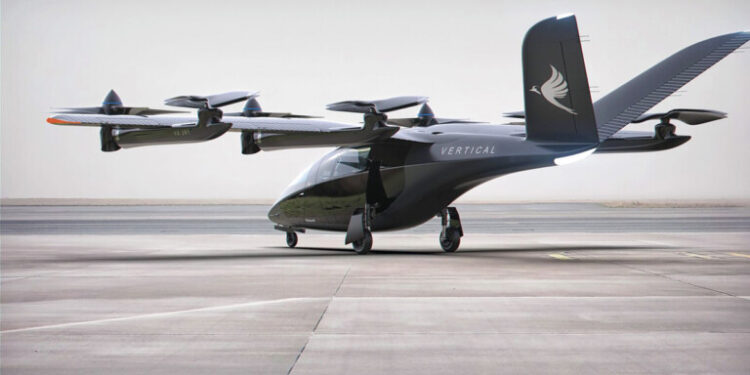
eVTOL Evolution
The Past, Present & Future of Air Mobility
From July through November 1919, one of aviation’s most important, though lesser-known, pioneers, US Army Air Corps Lt. Ernest Emery Harmon, successfully piloted the first fly around the rim of the continental United States.
This groundbreaking ‘Round-the-Rim’ trip captivated the public, generating front-page headlines across the country.
The flight took off from Bolling Field in Washington DC and flew counterclockwise westward across the northern states, along the Pacific Coast, eastward along the Mexican border, and then across the South, returning to Bolling in 114 hours and 45 minutes.
This nearly four-month mission was a watershed point in the history of manned flight.
A few months before the ‘Round-the-Rim’ flight, Harmon wrote a detailed article on March 30, 1919, New York Sun about the first trans-Atlantic flight in a ‘heavier than air machine.’
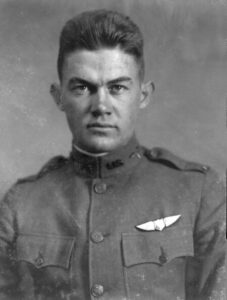
In it, he expressed his vision of the future of aviation and, in his own words, predicted, “I believe that the time is not far off when you will find aerial garages in every big city, where you can buy a plane and be taught to fly it, where you can store one overnight and where you can hire an aerial taxi to take you from one town to another, or an aerial bus to show you the city.”
Harmon’s futuristic vision of air mobility might have seemed like something out of a science-fiction novel over a century ago.
Still, his predictions and imaginative thinking helped shape the future of air travel and fuel a long string of innovations and transformative technology that turned concepts into reality.
Beginning with the inter-war years of the 1920s and 1930s, known as the ‘Golden Age of Aviation,’ and the early days of commercial air travel amid the Great Depression, struggling airlines were awarded government contracts to deliver the US Mail to help them ‘get off the ground.’
| Read More – 1st Electric Bike With ChatGPT Co-Pilot Unveiled- AI Bike |
Back in the day, getting off the ground literally required take-offs and landings from open grass fields and small dirt airstrips.
These would eventually prove to be unsuitable for a growing commercial air industry that would require an ample network of airports to support a successful air transportation system.
As more passengers chose to travel by air, albeit for business or by the wealthy who could afford its price tag, air routes expanded across the country, and more airliners took to the sky.
As these aircraft grew, airports evolved from grass fields to paved runways.
After World War II, with the rapid development of the jet engine and aeronautic technology, the airline industry grew swiftly, and thousands of passengers new to commercial air travel rose to new levels.
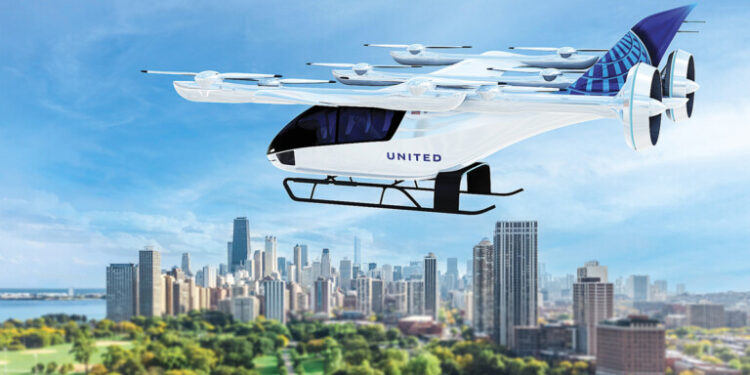
The 1950s ushered in the Jet Age, revolutionizing how people moved around and eventually making flying more affordable, efficient, and accessible.
VTOL – Vertical Take-Off & Landing
Amid the post-war boom of the late 1950s, air-minded innovators began turning their attention to personal VTOL (Vertical Take-Off and Landing) aircraft.
In support of Henry Ford’s 1940 assertion (which largely echoed Ernest Harmon’s 1919 prediction about air garages and taxis), he stated, “Mark my word…a combination airplane and motorcar is coming.
You may smile, but it will come,” in 1958 the Ford Motor Company experimented with a personal aircraft/concept car called the Volante Tri-Athodyne, a 3/8 scale concept model representing a car that used three ducted fans to move it through the air, enabling VTOL.
In Europe, with its development beginning in 1957, the Hawker P. 1127 was a British experimental aircraft that led to the Hawker Siddeley Harrier, the first V/STOL (Vertical and/or Short Take-off and Landing) jet fighter with a Pegasus vectored-thrust engine. Testing began in July 1960, and by the end of the year, the aircraft had achieved VTOL and horizontal flight.
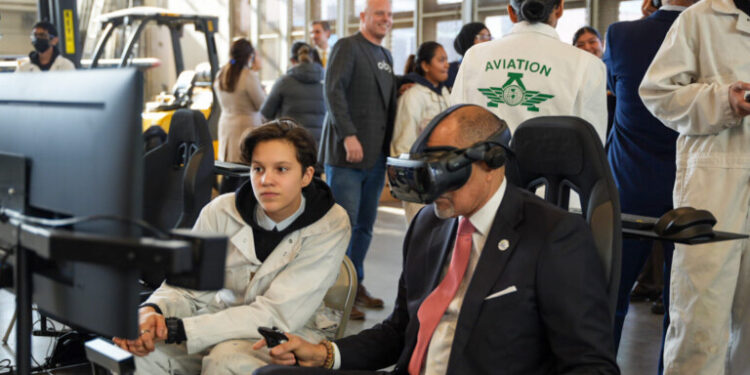
The Space Age & the 1960s Generation of Innovation
By October of 1957, the Soviet Union successfully launched Sputnik 1, the world’s first artificial satellite to orbit the Earth.
This marked the start of the Space Age and the Space Race between the United States and the USSR and triggered a new era of technological, scientific, and cultural developments that have continued into the present day.
The generation that grew up in the 1960s experienced a remarkable decade of revolutionary innovation that could be easily viewed as a ‘golden age’ of American aerospace ingenuity.
Through the incredible advancements made across the many fields of aviation, the inventions of this decade transformed the portrayals of science fiction and futuristic air travel into fact.
| Iconic technology of the 1960s included Telstar, the first active communication satellite launched in 1962, industrial robotics, the first functioning laser, BASIC computer programming language, weather satellites, video game consoles, the computer Mouse, Tasers, color TV, the microwave oven, the DRAM memory chip (Dynamic Random Access Memory), the Apollo Program beginning with Apollo 8 successfully orbiting the moon with three astronauts on board in 1968, and the landing of the Apollo 11 LM (Lunar Module) and the first human to walk on the moon in 1969. |
In addition, these technological innovations and inventions led to breakthroughs in computer software which would set the path for future space exploration and a vision for the future of air travel and increased urban air mobility.
Many technical achievements of the 1960s dominated the media and permeated the popular culture of America’s first generation of post-war youth.
In Flushing Meadows, Queens, the 1964 World’s Fair presented a showcase for mid-century culture and future technology, with over 140 pavilions representing 80 nations and a theme of ‘Peace through Understanding.’
General Motors debuted Futurama II, predicting colonies on the moon, commuter spacecraft, and moving walkways.
Bell Labs debuted its first Picturephone, where visitors to the fair could test the device at stations connected to similar devices across the country.
The Port Authority Heliport and Exhibit was a structure commissioned by the PANYNJ as an ‘aerial gateway’ for helicopter transportation from locations around New York City.
The 120-foot-tall heliport featured horizontal and vertical windows creating a ‘T’ for ‘Transportation’ on each side of the building, topped by a landing platform where helicopters landed on the roof and visitors to the exhibit could view a 12-minute film chronicling the history of transportation in New York City.
The pop culture of the 1960s yielded an array of science-fiction programming based on futuristic air and time travel, including ‘Star Trek, Lost in Space, The Outer Limits, and The Time Tunnel, to name a few. The popular animated cartoon, The Jetsons, first aired in 1962 on ABC
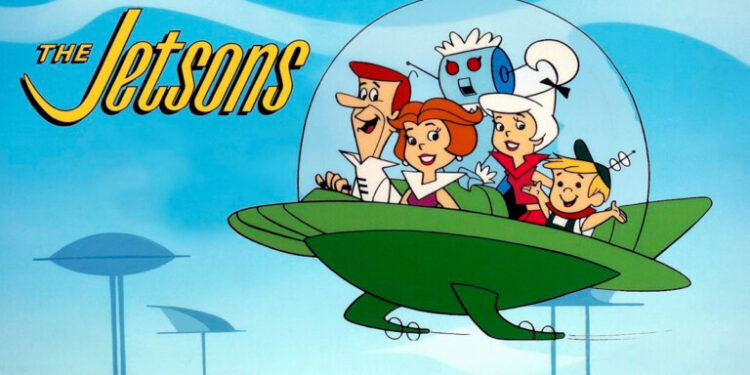
The Jetsons were a family who lived in Orbit City, a futuristic city comprised of homes and businesses raised high above the ground on adjustable columns.
George Jetson and his wife, Jane, lived in the Skypad Apartments with their teenage daughter, Judy, their son Elroy, and their dog, Astro. Their housekeeper, Rosie, was a robot who handled household chores with the help of the many space-age, push-button devices, most of which did not yet exist in the 1960s but that has since been invented and commonly used and enjoyed today; the flatscreen TV, a newspaper read on the computer, video chats, computer viruses, and a home treadmill.
The most captivating device was the transparent bubble-topped flying vehicle that George commuted to work in each day while on his way to Spacely Space Sprockets, literally dropping off his kids and wife in clear dome-covered saucers that carried them to school and the shopping center.
Until recently, the concept of flying cars and air taxis had been mostly a pipe dream, but today the reality of this pipe dream is just around the corner and will be delivered through eVTOL technology.
One of the newest innovations in the aviation and aerospace industry is eVTOLs, or Electric Vertical Take-Off and Landing vehicles.
eVTOLs (pronounced ‘ee-vee-tolls’) are aircraft that have large omnidirectional fans and propellers that help the vehicle to take off vertically and move in any direction.
Josh Stoff, curator of the Cradle of Aviation Museum in Garden City, NY, further explained, “eVTOLs are a new type of aircraft, neither airplane nor helicopter, carrying one or more people for recreational flight or air taxi services.
They are vehicles that use electric power to hover, take off and land vertically. This technological revolution came about thanks to steady advances in electric propulsion (motors, batteries, electronic controllers) beginning in the late 1960s, combined with the current need for new types of vehicles (mainly air taxis) for urban air mobility as the roadways in major cities approach gridlock.
We now stand on the edge of this revolution in flight as aerospace technology has finally reached the point where electric air taxis are possible.
The emergence of this alternative to traditional ground transportation has been enabled by the development of unmanned aerial vehicle technology such as drones, in recent years, combined with electric propulsion.”
Modern consumer drones are essentially miniature eVTOLs, but following the success of drones used for photography, filmmaking, and military use, eVTOLs are getting bigger.
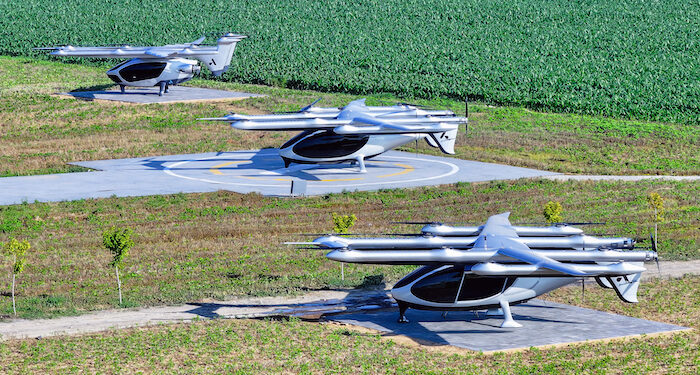
As this new class of air vehicle begins to emerge, they will transform how people and cargo are transported. As air taxis, they will move people and goods around and between cities.
In addition, they can be used for emergency medical services and first responders, the police, fire departments, the military, and a wide variety of other applications. While cost and safety are two hurdles in eVTOL development and its adoption, eVTOL offers the promise of quiet, efficient, environmentally friendly, zero-emissions transportation.
The concept of eVTOL emerged in 2009 when NASA released a video of the NASA Puffin eVTOL concept, conjured up by aerospace engineer Mark Moore, who created a design for an unusual-looking, electric-powered vertical take-off and landing air vehicle as part of the coursework for his doctoral degree. Once the Puffin concept was posted on YouTube, it became a web sensation that received over 648,000 hits in one week, a classic example of the powerful viral nature of the web. In his paper ‘NASA Puffin Electric Tailsitter VTOL Concept,’ for the American Institute of Aeronautics and Astronautics Moore wrote, “Electric propulsion offers dramatic new vehicle mission capabilities, not possible with turbine or reciprocating engines; including high reliability and efficiency, low engine weight and maintenance, low cooling drag, and volume required, very low noise and vibration, and zero emissions.”
The three methods that eVTOLS operate are:
- The tilt-thrust method, where the propellers can change position from providing all the lift necessary to get the aircraft off the ground to a forward-facing position, generating propulsion, while more traditional wings provide lift;
- Lift and cruise; where several propellers provide lift like a helicopter, while a second fixed motor provides forward propulsion;
- a multi-rotor system that works like drones that are flown around neighborhoods, with multiple fixed rotors providing upward lift and forward thrust by tilting the vehicle forward. This technology emerged due to significant advances in electric propulsion, namely motors, fuel cells, batteries, remote electronics, and the growing need for Urban Air Mobility and Advanced Air Mobility (UAM/AAM)
A White Paper NASA Transformative Vertical Flight Working Group document, dated August 2021, stated that “more than 150 companies are in the process of developing prototypes in a fierce competition between startups, including EVE (US), Joby Aviation (US), Lilium (Germany), Vertical Aerospace Group Ltd. (UK), E-Hang (China), Volocopter (Germany), as well as large firms like Airbus, Boeing (US), Bell (US), Embraer (Brazil), and Uber (US).
Additionally, the Big Four technology companies, Amazon, Google, Apple, and Facebook (US), known for disrupting well-established industries through technological innovation, are moving into the eVTOL aircraft endeavors, placing vast venture capital and highly talented human capital into these efforts.
Venture capitalists have invested more than one billion dollars into promising eVTOL aircraft startups.
Well-known CEOs, billionaires, and politicians are leveraging personal credibility supporting eVTOL projects.”
As eVTOL air taxis advance toward certification and operation in the US, aviation regulators project the first commercial air taxi services to begin in late 2024 or early 2025.
As far as the infrastructure required by eVTOLs to enable Urban and Advanced Air Mobility (UAM/AAM), the construction and operation of ‘Vertiports’, specifically designed for UAM, will facilitate the transport of people and cargo more rapidly and effectively than traditional airports.
The biggest hurdle eVTOL manufacturers face will be obtaining stringent regulatory approval from government agencies, such as the Federal Aviation Administration.
At that point, they will need to receive certification that their aircraft are exceedingly safe for commercial passenger operations and certifications for pilot training, airspace integration, vertiport licensing, and more.
At the forefront of evolving all-electric aircraft for commercial passenger service is California-based Joby Aviation, Inc. (Joby).
Joby has spent over a decade developing and testing zero-emissions aircraft that will travel 150 miles on a single charge, enabling a pilot and four passengers to leapfrog over city congestion below at speeds of up to 200 mph.
With more than 1,000 completed test flights over ten years, Joby aircraft has been designed to meet the rigorous safety standards set by the FAA and other global aviation regulators.
As one of the leading, innovating companies on the precipice of fulfilling Ernest Harmon’s 1919 vision of future air transport and Urban Air Mobility, announced on May 26, 2022, that Joby Aviation received a Part 135 Air Carrier Certificate from the FAA, allowing the Company to begin on-demand commercial air taxi operations.
The Part 135 Air Carrier Certificate is one of three FAA approvals required for Joby to operate its revolutionary electric vertical take-off and landing (eVTOL) aircraft as an air taxi service in cities and communities across the United States, alongside a Type Certificate and a Production Certificate.
In the 104 years since Harmon’s prediction, from the earliest days of commercial aviation through post-war and the innovations of the 1960s and the Space Age… vision has become a reality.


















